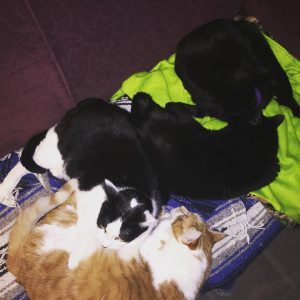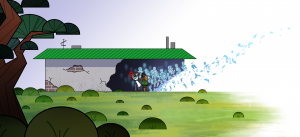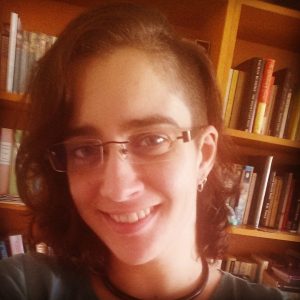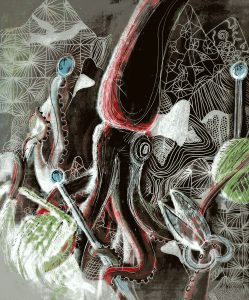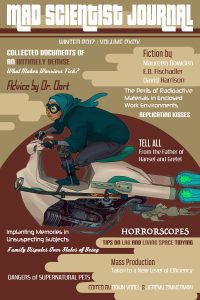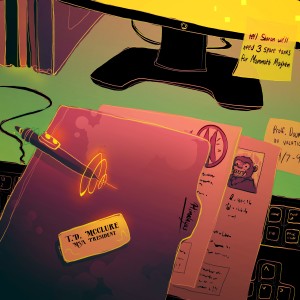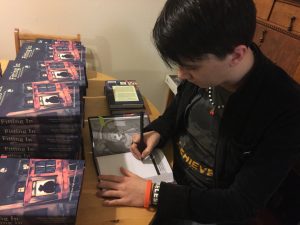An essay by Professors Tabitha and Helga Krantz, Department of Supernatural Zoology, University of Morbach, Germany
Provided by Andy Brown
Art by Luke Spooner
The purpose of this project was to explore the potential uses of naturally produced supernatural zoological fluids. It was partly financed by the Supernatural Animal Protection Society (SAPS) as part of the recent SAPS proposal to raise awareness about the invasive procedures used in previous research into supernatural creatures.
~
Troll Grease
Troll grease is found in great abundance in the armpits, the buttock cleft, between the thighs, behind the ears, and in the belly button of trolls. This foul smelling, dark brown substance has the consistency of soft cheese. Trolls must be sedated before collecting the grease, which has to be scraped from the creature using large metallic spoons. Occasionally, hammers and chisels have to be used to remove solidified lumps.
The grease has a number of applications. In its raw form, it acts as a powerful repellent. A 2 milligram piece of grease is enough to clear a house of any pests, from termites and spiders to rats and birds. It needs to be treated with caution, as it is equally repellant to humans. Hazmat suits had to be worn at all times during tests to protect our team from the effects of the grease. Raymond, our lab technician, was rendered unconscious for several days after he was exposed to a dirty chisel.
When diluted (1:150,000) in alcohol, the grease had powerful stimulant properties. During tests, three of our students stayed awake for 120 hours by using a nasal spray every 4 hours. Mentally and physically, the students performed at approximately 150% of normal. Side effects included a marked loss of olfactory response, protruding eyeballs, and flatulence. When the effect of the spray wore off, the students lapsed into unconsciousness for 20 hours.

Sirens are very dangerous to store while milking, since the slightest sound produced by these creatures is enough to induce a trance. A system was developed that utilised a noise-cancelling version of an air lock. Full noise-cancelling helmets had to be worn at all times in the presence of the sirens.
To read the rest of this story, check out the Mad Scientist Journal: Winter 2017 collection.
Professors Tabitha and Helga Krantz are conjoined twins who share a torso and internal organs. They obtained degrees in Biology, Chemistry, and Crypto-Zoology at the University of Harghita in Transylvania. Tabitha and Helga have six brothers, who are also conjoined twins. The Krantz family motto is “Duo Capita Sunt Meliora Quam Unum” (Two Heads Are Better Than One).
Andy Brown is a musician and entertainer living near Edinburgh in Scotland. (He doesn’t currently own a kilt but does play bagpipes a little.) He is a pleasant enough fellow with a healthy interest in many things and an obsessive interest in many others. (Music, computers, astronomy, reading, writing…) He plays a wide variety of instruments to a wide variety of standards. His greatest happiness is his family and the fact that he wakes every morning still breathing. His greatest sadness is that he might die before warp travel, teleportation, and Klingons are discovered.
Luke Spooner, a.k.a. ‘Carrion House,’ currently lives and works in the South of England. Having recently graduated from the University of Portsmouth with a first class degree, he is now a full time illustrator for just about any project that piques his interest. Despite regular forays into children’s books and fairy tales, his true love lies in anything macabre, melancholy, or dark in nature and essence. He believes that the job of putting someone else’s words into a visual form, to accompany and support their text, is a massive responsibility, as well as being something he truly treasures. You can visit his web site at www.carrionhouse.com.
“Supernatural Zoological Fluids and Their Applications” is © 2017 Andy Brown
Art accompanying story is © 2017 Luke Spooner

